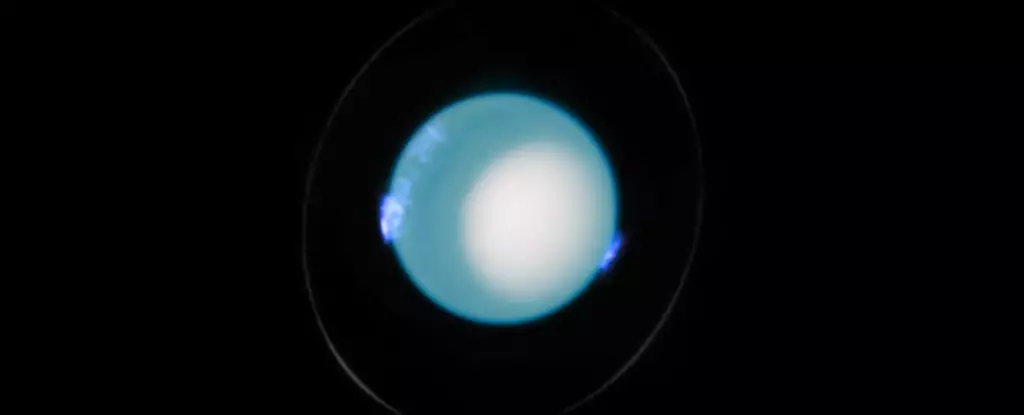The mysteries of the outer Solar System often take a backseat to studies of their inner counterparts, yet recent revelations regarding Uranus have thrown the spotlight back on this intriguing planet. It seems that our understanding of the length of a day on Uranus has required a tedious correction. New findings suggest that a full rotation takes 17 hours, 14 minutes, and 52 seconds—an adjustment of 28 seconds longer than prior calculations that relied on dodgy data from the Voyager 2 flyby in 1986. While some might disregard the significance of this discrepancy, the implications are profound and far-reaching.
The Importance of Accurate Timekeeping in Astronomy
The excitement generated by this seemingly small adjustment unveils a larger narrative about the nature of scientific inquiry. As highlighted by Laurent Lamy, an astrophysicist at the Paris Observatory, this newfound precision acts as a foundational reference point for the astronomical community. This is not merely a numerical tweak; it’s a critical need to rectify outdated models that have led to confusion, particularly regarding the orientation of Uranus’ magnetic poles. The loss of consistent tracking due to prior errors has significant implications for our understanding of this distant planet’s behavior and characteristics.
Imagine navigating an uncharted ocean with navigation maps drawn from outdated coordinates—every wave you encountered would feel foreign and unpredictable. This scenario parallels our understanding of Uranus, where persistent inaccuracies made it nearly impossible to monitor one of the Solar System’s most enigmatic giants over time.
Challenges in the Outer Solar System
Studying Uranus, along with its neighboring giant Neptune, is a complex endeavor. These planets exist at substantial distances from the Sun, approximately twice and three times further than Saturn, respectively. Consequently, they are often reduced to distant, faint specks in the night sky, making detailed observation burdensome. Limited exploratory missions have only brushed against the surface of their potential wonders—Voyager 2 remains the only craft to have provided close-up insights into Uranus.
Understanding the dynamic environments of these gas giants is vital. The inherent challenges of distance introduce biases based on the specific atmospheric conditions present during flybys, complicating our grasp of Uranus’ rotational dynamics. Despite our technological advances, gaining fresh insights into these remote worlds is an ongoing challenge fraught with uncertainties.
The Role of Innovative Techniques
New methodologies, however, are rising to the occasion. The implementation of cutting-edge techniques using data from the Hubble Space Telescope is a testament to human ingenuity in the face of astronomical challenges. Between 2011 and 2022, Hubble picked up Uranus’ ultraviolet auroras—natural marvels analogous to the auroras we bask in on Earth. By carefully tracking these phenomena, researchers can glean critical data about Uranus’ magnetic poles and, ultimately, its rotation.
This approach underlines a fascinating aspect of Uranus: its rotational axis is nearly parallel to the ecliptic plane, which is a stark contrast to the orientation of other Solar System bodies. This unique orientation, along with its far-flung placement, complicates efforts to pinpoint the planet’s magnetic poles. Yet, by studying the nuanced dance of charged particles influenced by solar winds, scientists managed to unearth an accurate length of a Uranian day.
A New Era of Exploration
As Lamy and his team have disclosed, their remarkably precise measurements stand as the most accurate assessment for a gas giant to date, even surpassing that of Jupiter. This newfound understanding not only sets the stage for meticulous comparative studies across all major planets but also lays the groundwork for future missions targeting Uranus. The ability to analyze data spanning decades opens a myriad of possibilities for learning about Uranus and its mysteries, from atmospheric dynamics to magnetic field peculiarities.
Such advancements are invigorating. They ignite the passion for discovery, sparking intrigue that propels scientists and space enthusiasts alike to engage with these ethereal entities that linger on the periphery of our knowledge. As this new longitude system emerges, the potential to study Uranus with greater clarity serves as a reminder of the limitless nature of discovery—the wonders that lie beyond our immediate understanding waiting to be unveiled. The revelation of Uranus’ day length is not merely an adjustment in numbers; it’s a gateway to a renewed understanding of the cosmos around us.

